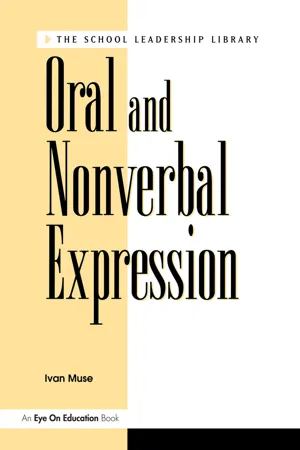Body Language
Body language refers to the non-verbal signals and cues that individuals use to communicate their thoughts, feelings, and intentions. This can include gestures, facial expressions, posture, and eye movements. In psychology, body language is studied to understand how it influences interpersonal interactions, relationships, and overall communication.
8 Key excerpts on "Body Language"
- eBook - ePub
Multi-generational Family Therapy
Tools and resources for the therapist
- Maurizio Andolfi(Author)
- 2016(Publication Date)
- Routledge(Publisher)
...8 Body Language IN FAMILY THERAPY Language, as explored in the preceding chapter, is based not only on what we explicitly verbalize but, even more importantly, on what we express without words. This implicit level of communication is provided by Body Language which is made up of all those non-verbal signals (mimicry, posture, movements, facial expressions) that are the foundation of kinesics together with the paralinguistic system, characterized by tone, voice frequency and rhythm and, lastly, by silence. Non-verbal communication is also based on proxemics that analyse how space is occupied in terms of greater or lesser physical distance, and the relational boundaries and multiple messages transmitted through physical contact. All these signals assume a relevant affective and cognitive value. We speak with our body, looks, posture, intonation and pauses between words. Things are communicated by non-verbal expressions much more frequently during our early development than in adulthood. Even though Body Language is a more spontaneous and universal way of communicating, as it is less bound by rules than verbal language, there is no general theory of non-verbal behaviour. In spite of increasing research in this field, we are still a long way from integrating it into a coherent body of knowledge. In sum, there are no grammatical rules we can learn from, but rather, it is a language to be interpreted, and as such, it is subject to ambiguity and can create a lack of understanding on a cultural level. Birdwhistell (1970), Scheflen (1972, 1974) and Kendon (1994), the pioneers of kinesics, worked out a series of concepts and terms that refer to everyday actions (for example, behaviour at the table, around the home, greetings, kisses and birthday celebrations). The work of these authors revealed the enormous variety of experiences that are observable in spontaneous interactions, and the social and cultural nature of these non-verbal expressions...
- eBook - ePub
Purchasing Performance
Measuring, Marketing and Selling the Purchasing Function
- Derek Roylance(Author)
- 2016(Publication Date)
- Routledge(Publisher)
...CHAPTER 11 Body Language (NON-VERBAL COMMUNICATION) DEFINITION To even raise this subject may seem to fly in the face of the general tenure of a book that thus far has preached a message of objectivity and fact-based analysis. It would be wrong, however, to think that overwhelming logic alone is a sufficiently powerful weapon to win over doubters. However desirable it may be to always remain in control and completely objective, it would be foolish to ignore the fact that it is actually impossible to ignore our own and others’ subconscious subjective feelings as we all go about our everyday work. We constantly express our feelings towards others in the form of Body Language, even if we may be trying to hide or suppress them. A definition of Body Language is all non-verbal communication including facial expressions and body movements. These movements and gestures will reveal our true subconscious feelings and may run completely contrary to the actual words being used at the time. It can also include the way we define ourselves in the way of the fashions we wear and ancillary objects we choose. For instance, it would be hardly surprising to receive different reactions from people if we drove a shiny new Rolls Royce one day and a beaten up old banger the next. Similarly to turn up for an interview for a job as a financial adviser at a City bank dressed in an ancient T-shirt and scruffy jeans would not be a wise move, no matter how much we knew about banking. The T-shirt and jeans may, however, be quite appropriate for an interview with a website design creative director, providing they are clean and looking generally new and immaculate. Humans are social animals that cannot exist without one another and as soon as we are in contact with others of our species we begin communicating...
- Sally Everett, Nicola Cade, Abigail Hunt, Deborah Lock, Katie Lupton, Steve McDonald(Authors)
- 2020(Publication Date)
- SAGE Publications Ltd(Publisher)
...It is about building a positive connection between yourself and others. Introduction This chapter draws on the theories of non-verbal communication (kinesics) and concepts such as haptics (touching and how it is used in communication, e.g. effective use of handshakes) and proxemics (space and spatial relationships) to explain the role of Body Language. It particularly looks at the role of Body Language in terms of fostering effective communication and how it reveals attitudes and feelings. This chapter outlines how to read Body Language, how to be aware of your own Body Language and reveal what it is saying about you and your thoughts. Non-verbal behaviour is crucial to understand, especially as you think about securing employment, working with others and presenting yourself most effectively. In breaking down different elements to look at, such as facial expression, gestures, physical positioning and oculesics (eye movements, eye behaviour, gaze and eye-related non-verbal communication), this chapter helps you think about how others are perceiving you and how to improve your silent communication, but also helps you read signs from other people which is particularly useful in the service industries like tourism, hospitality and events. A history of Body Language How many times have you heard the phrase, ‘actions speak louder than words’? It is true in many ways because our Body Language conveys a lot more than the spoken word and arguably, it is certainly more truthful. Our bodies play a key role in conveying our feelings, our views, emotions and messages. The way we use non-verbal physical action has a much longer history than spoken communication. Indeed, human beings were using different physical movements to express emotion and attitudes hundreds of years before spoken words. Physical gestures provide key signs and signals...
- eBook - ePub
Negotiation for Procurement and Supply Chain Professionals
A Proven Approach for Negotiations with Suppliers
- Jonathan O'Brien(Author)
- 2020(Publication Date)
- Kogan Page(Publisher)
...12 Body Language This chapter explores the unspoken forms of communication through our gestures, reactions and Body Language and what these say and give away. Pathway questions addressed in this chapter What tactics and techniques will help me be successful? How can I stay in control of my Body Language and read that of my opponent? Red Sheet steps covered in this chapter 12 and every interaction with the supplier Non-verbal communication When we engage in face-to-face discussion with someone, believe it or not, only around 7 per cent of the message they receive is based upon the actual words that are said; paralanguage accounts for 38 per cent. Paralanguage is what is implied by the sound of our voice: our pitch, tone and speed. The remaining 55 per cent of our message is delivered through our Body Language (Borg, 2010). For this reason face-to-face negotiations work differently from those conducted remotely. However, negotiation is increasingly being conducted by remote means, some with, some without the means to see the other party and their non-verbal communication. Why we need to understand Body Language Body Language is our demeanour, what our bodies do and how part or all of our bodies move and react to what is happening around us. To the trained eye our bodies can tell more about what we are thinking than we may even be aware of ourselves. It might seem crazy to think that we could reveal so much. Surely we can manage how we act? However, it is almost impossible to completely suppress involuntary bodily reactions. The reason for this is that we have evolved with incredibly powerful brains that take care of everything, constantly monitoring what is going on all around us and reacting instantly without conscious thought...
- eBook - ePub
- Diana Jackson-Dwyer, Craig Roberts(Authors)
- 2015(Publication Date)
- Psychology Press(Publisher)
...rehabilitation of criminals, customer-service training, managing conflict by managing Body Language Key terms Here is a list of important terms that you should learn in your revision. Try to write definitions for these after reading the chapter, and check your answers in the glossary on pp. 129–135. Essential terms that you must know in order to properly understand the topic are marked with an asterisk. Body Language* Evolutionary theory Eye contact Facial expression Non-verbal communication* Postural echo Social learning theory* Verbal communication* Non-verbal communication Definitions • Verbal communication is communication that involves speech or is in written form. • Non-verbal communication (NVC) involves messages expressed by communication other than linguistic means, that is, communication that does not use words. This includes the expression in the voice, gestures and Body Language. Non-verbal communication can be divided into two types: 1. Communication during speech, such as the tone of voice, the pausing, the “hums and haws” and the general pace of the speech. 2. Communication that does not involve any speech at all, such as our posture or facial expression. Body Language Posture Posture is the way in which we walk, stand or sit (i.e. the way we hold our body) and is an important means of NVC. The following table gives examples of this means of communication. Posture Meaning Hunched shoulders with head down Lack of confidence Shoulders back with head held high Self-confidence; authority Relaxed posture "At home" feeling; lack of anxiety Orientation of body towards a person, especially if leaning forward Interest in the person Leaning back from a person Lack of interest in the person, or rather shy or reserved Back straight with chest out: "puffing up" Aggression and/or high status Open and closed posture The table above shows the meaning of various body postures...
- eBook - ePub
The Secret Language of Business
How to Read Anyone in 3 Seconds or Less
- Kevin Hogan(Author)
- 2010(Publication Date)
- Wiley(Publisher)
...You’ll notice how his voice is used to set the tone for a story and convey the appropriate context. Chapter 3 TAKEAWAYS 1. The elements of Body Language include both physical body parts and how those body parts are used. 2. The key elements include eyes, face, gestures, touch, posture, movement, appearance, and voice. 3. The eyes convey messages with both deliberate Body Language (eye contact, direction of gaze) and spontaneous Body Language (pupil dilation, blinking). 4. Facial expressions are thought by many to be the most important of all nonverbal behaviors. They convey emotion and regulate and direct an interaction. 5. Gestures are movements used to communicate a message or enhance communication of a message. They are deliberate and intentional; the two categories of gestures are speech-independent gestures (thumbs up, arm wave) and speech-related gestures (emphasize a point, describe a topic). 6. Touch generally falls into one of four categories: professional, social, friendship, and intimacy. There can be a tremendous amount of overlap between these categories due to factors such as age, gender, status, circumstances, and culture. 7. Posture includes several contributing aspects: head position, shoulder position, arm position, hips, and legs. It can be used in ways such as to influence first impressions, create understanding, and discourage attention. 8. Movement is powerful yet flexible in how it can be used. It can convey such things as familiarity, status, dominance, submission, aggression, support, and encouragement. 9. Appearance includes body shape and size, face and hair, clothing, and the like. It is particularly powerful when it comes to creating a first impression. There are some strong generational differences in what is considered appropriate and inappropriate in terms of appearance. 10. Voice is a nonverbal tool that includes aspects such as tone, pitch, tempo, emphasis, emotion, and so on...
- eBook - ePub
Stand Out
How to Build Your Leadership Presence
- Carol Kinsey Goman(Author)
- 2020(Publication Date)
- Kogan Page(Publisher)
...The human brain is hardwired to read and respond to these nonverbal cues, but because some leaders aren’t aware of what they are communicating, they are unequipped and unable to use Body Language to their advantage. Without realizing it, they are sending a multitude of nonverbal signals to clients and colleagues in every business encounter. But not you! In this chapter, I help you manage your nonverbal communication so you can use Body Language that highlights your leadership presence. The Science behind Body Language Research by the MIT Media Lab shows how subtle nonverbal cues provide powerful signals about what’s really going on in a business interaction. These researchers have invented a sociometer, a specially designed digital sensor that’s worn like an ID badge. A sociometer doesn’t record what’s said but rather what isn’t being said: nonverbal signals and interactions that include tonal variety, vocal nuance, physical activity, energy levels, even the number of smiles and nods exchanged. Based on data from these devices, researchers with no knowledge of a conversation’s content can predict the outcome of a negotiation, the presentation of a business plan, or a job interview in two minutes—with over 80 percent accuracy. 4 But nothing has added more to the scientific validity of the impact of Body Language than neuroscience and the use of fMRIs. Magnetic resonance imaging (MRI) uses radio waves and a strong magnetic field to take clear and detailed pictures of internal organs and tissues. Functional magnetic resonance imaging (fMRI) applies this technology to identifying regions of the brain where blood vessels are expanding, chemical changes are taking place, or extra oxygen is being delivered...
- eBook - ePub
- Ivan Muse(Author)
- 2013(Publication Date)
- Routledge(Publisher)
...When this occurs, the speaker, looking intently at the listener, may think that a physical cue has been given, and that the listener is questioning a proposal or idea. The speaker may even comment, “I can see by your frown that you are not in agreement with my idea.” The listener may seem surprised that the speaker had picked up such a meaning, and hurriedly remark, “Oh, no! I like your idea. I was just thinking through how others who would be involved would respond.” The school principal should be aware that when giving a message and using nonverbal cues, the listener may become confused if the cues and spoken comments are not supportive. Thus, a habitual glance at your wrist watch or a shuffling of paper on the desk might be interpreted by a visitor as a signal that you are busy, pressed for time, or that the meeting must end soon. As people interact, they are giving nonverbal cues, and, simultaneously, these cues are being observed by each participant in an attempt to determine what the other is thinking and feeling. There are three major forms of nonverbal behaviors that accompany and supplement language. The three areas with related subgroups are: ♦ Paralanguage Voice loudness Speed of speaking Tone of voice ♦ Body Language Appearance Facial signals Gestures ♦ Space Personal Touching Physical environment Each one of these areas will be discussed and their importance in the process of communication explained. P ARALANGUAGE The way that an individual uses language can say as much about the person as the words and sentences uttered. Paralanguage consists of nonverbal voice cues that accompany speech. The speaker’s loudness, speed of speech, pitch of voice, tone or emphasis on words, and inflection give added meaning to the spoken words. Even stuttering, whimpering, yawning and giggling give the observer impressions of the speaker and the intent of the message. A few people stutter when they become nervous or feel strongly about some issue being discussed...







